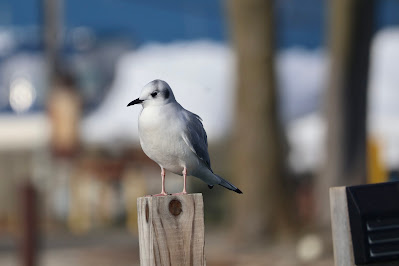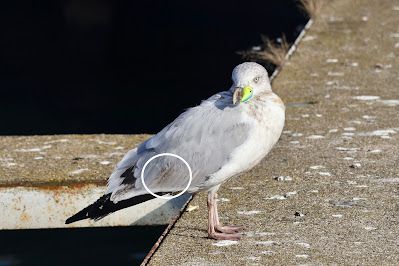On Tuesday, 11/19 I went to Humbug Marina to look for the many times reported Little Gull (Hydrocoloeus minutus). I arrived to find myself alone for the task of locating this small and beautiful gull. I would only be able to identify it if the bird was in flight. Shortly after arriving I was joined by another birder who used her long lens camera as her bins. It seemed to work for her. Later we were joined by two guys, one with a spotting scope. We all introduced ourselves and chatted as we searched. Usually this means more chatting and less searching. The bird had, apparently, been seen by another birder earlier that morning. Alas, for the four of us, we did not see it. If it was seen again later in the day, I don't know. I was a little disappointed.
Above and below Bonaparte's Gull (
Chroicocephalus philadelphia). A closed winged bird makes it challenging to see the field marks important to age this bird. While it does have pale pink legs, Amar Ayyash does not mention these specifically.
Above and two below: I think this is an adult bird in basic plumage. Orange-red legs are shown in photos (pages 111-112) of adult birds in alternate plumage. Bonaparte's Gull, even without its slaty hood, is surely a pretty gull. I attended a Zoom presentation by Amar Ayyash in which he mentioned that this gull is the only gull to nest predominately in trees, with a preference for black spruce trees, in our very northern boreal forests. Thus, a new name for this species may reference its unique arboreal-nesting habit (
The Gull Guide, North America, page 106).
Above: Adult Herring Gull (Larus Smithsonianus)

Above and two below: Unfortunate adult Herring Gull with a small fishing lure securely caught in its nostrils. We hear and read of this happening all the time. Occasionally, I have also seen it. Once I saw a plastic six-pack holder strangling a Canada Goose. Ever since I have always carefully cut anything like ringed plastic into pieces thereby making this impossible to happen. In this gull's case it appears to be a fishing lure that is cast out and waddles along the water's surface or just slightly below the water as the fisherman slowly reels it back in. Such a design is to attract a fish to strike from below. In this case, I think the gull likely struck from above. In all of the photos a faint stain of red is seen on the lower wing feathers. My guess is that this is likely to be a blood stain that resulted when the bird attempted to dislodge the lure from its bill. While it is unclear from these photos if the gull can still open and close its bill, a close look reveals that it will be severely constrained.
It's important to see this.
Unfortunately, it seems unlikely the bird can survive long.










No comments:
Post a Comment